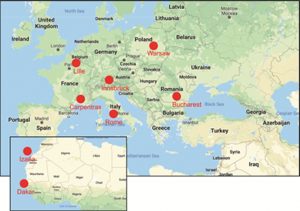Observation techniques
Aerosol lidar
A typical aerosol lidar is based on a commercial and hence affordable Nd:YAG laser with its three emitted wavelengths 355, 532, and 1064 nm. At these wavelengths the lidar measures elastically backscattered photons from which the aerosol backscatter coefficient can be deduced with an assumed ratio between extinction and backscatter, i.e. the so called lidar-ratio. The measurement range is nowadays typically from 500 m a.g. to 15 km a.g.. During night it is possible to measure the orders of magnitude weaker signals from inelastically backscattered photons from atmospheric gases at vibrational or rotational shifted Raman wavelengths (e.g. 387, 408, 607 nm), from which – together with the elastic signals – the aerosol extinction coefficient can be retrieved.
EARLINET, the European Aerosol Research Lidar NETwork, is a continental-scale ground based lidar network, which provides quality assured optical profiles on a large temporal and spatial scale (Pappalardo G. et al., 2014). Currently with 27 lidar stations in Europe, EARLINET data is relevant for climatology, but also for special events, with strong aerosol influence: Saharan dust outbreaks, forest-fire smoke plumes transported over large areas, photochemical smog and volcano eruptions (e.g. Mona L. et al., 2012; Nicolae D. et al., 2013, Tesche M et al. 2009, 2011). EARLINET has developed a suite of quality assurance methods at both the hardware and software level to ensure the quality of lidar products. EARLINET is now part of ACTRIS (Aerosol, Clouds and Trace gases Research InfraStructure).
Automatic sun/sky/lunar photometer
The instrument is a sun/sky/lunar photometer making two basic measurements, direct sun/moon and sky measurements, possibly including linear polarization, both within several programmed sequences or protocols. The direct measurements are currently made in nine spectral bands (340, 380, 440, 500, 670, 870, 940, 1020 and 1640) and will be likely performed with a higher spectral resolution in the future.
AERONET, the Aerosol Robotic Network is a program involving over 300 passive remote sensing stations across the world producing routinely, in real time and publically available, high-quality aerosol column integrated properties such as AOD (Aerosol Optical Depth), optical and microphysical properties and many others derived radiative properties widely used by academic and industrial actors involved in climate and air-quality fields. It is strongly contributing, at the European level, to several relevant integration/synergetic activities with lidar, in situ observation, satellite and modelling (Dubovik O et.al 2002). AERONET-Europe, the European branch of AERONET, is providing, in the framework of ACTRIS, calibration, technical supports for maintenance of sun and lunar photometer including data quality control. These services are managed by LOA (CNRS/Lille University) in cooperation with Meteo France, Meteo Spain (Izana) and University of Valladolid. The calibration system has been designed to provide AOD calibration (based on natural sunlight source), sky radiance and polarization calibration (using integrating spheres and additional optical system to calibrate polarisation).
Pandora
Pandora is UV-VIS spectrometer designed to perform direct sun, direct moon, and sky radiance observations covering the entire wavelength range from 300 to 900nm.
Pandonia is a planned ground-based remote sensing network5 of Pandora spectrometer systems. The Pandonia network is intended to deliver total and tropospheric columns of ozone (Herman J. et al., 2006; Tzortziou M. et al, 2012 + 2013; Reed A. et al., 2013), nitrogen dioxide (Herman et al., 2009; Wang et al., 2010; Reed A. et al., 2013; Tzortziou M. et al, 2013; Knepp et al., 2013), sulfur dioxide (Knepp et al., 2013), formaldehyde (Pinardi et al., 2013), water vapour, and spectral AOD in the ultraviolet (>300nm) and visible range.
Observation sites

| Station name | Contact person | Coordi-nates | Site type | Facilities |
| Bucharest | Livio Belegante
livio@inoe.ro
|
44.35N
26.03E 93m |
Sub-urban, flat terrain | Aerosol, ozone, and water vapour lidars, sun/lunar photometer, Pandora-2S, microwave radiometer, optical laboratory |
| Lille | Philippe Goloub
philippe.goloub@univ-lille1.fr
|
50.61N
3.14E 60m |
Urban | Aerosol and water vapor LiDARs, photometers (sun/sky/lunar/polarization, AERONET), UV spectro radiometer (ozone, NDACC), FTIR, calibration site (optical labs), Infrared scanning radiometer, aerosol in situ optical measurements, particle counter, aerosols sample for chemical analysis, Solar and Infrared radiative fluxes |
| Innsbruck | Matin Tiefengraber
martin.tiefengraber@luftblick.at |
47°N
11°E 616m |
Mountain | 2 x Pandora (1S and 2S), microwave radiometer (HATPRO), doppler LiDAR, in-situ NO2 (cavity ring down spectrometer), in-situ NOx (chemiluminescence detector) photometer, meteorological sensors, optical laboratory |
| Izaña | Emilio Cuevas
ecuevasa@aemet.es |
28°N
16°W 2360m |
High altitude mountain and Volcano | Pandora, radio- & ozone-sondes, Brewer triad, FTIR, photometers, optical laboratory |
| Carpentras | Philippe Goloub
philippe.goloub@univ-lille1.fr
|
44.08N
5.06E 100m |
Rural | AERONET sun calibration site (sun/sky/lunar/polarization), solar and infrared radiative fluxes. |
| Dakar | Philippe Goloub
philippe.goloub@univ-lille1.fr
|
14.39N
-16.96E 12m |
Costal, rural and near desert site | Aerosol LiDAR, photometers (sun/sky/lunar/polarization, AERONET), FTIR (temporary), Infrared Scanning Radiometer, aerosol in situ optical measurements, TEOM, Solar and Infrared radiative fluxes |
| Rome | Marco Cacciani
marco.cacciani@uniroma1.it |
42°N
12.52°E 75m |
Urban | Pandora, Sun photometers, Spectrophotometer, Radiometer, Lidar, Sodar, meteorological sensors, all sky camera |
| Warsaw | Iwona Stachlevska | 52°N
21.1°E 100m |
Urban, flat terrain | Multiwavelength Raman polarization lidar, Sun/sky photometer |
